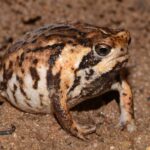- Leptodactylodon bicolor: Discovering the Secretive Jewel of Africa's Montane Streams
- Taxonomy and Classification of Leptodactylodon bicolor
- The Enigmatic High-Elevation Habitats of Leptodactylodon bicolor
- A Jewel of the Highlands: Appearance and Unique Adaptations
- Insights into Behavior, Diet, and Life Cycle
- An Important Thread Within the Ecosystem
- Facing a Cloudy Future: Conservation Challenges and Outlook
- A Cultural and Scientific Gem to Cherish
- The Time to Protect Our Hidden Treasures is Now
Leptodactylodon bicolor: Discovering the Secretive Jewel of Africa’s Montane Streams#
Deep within the mist-shrouded mountains of Cameroon, nestled amidst thick mosses and tangled roots stretching down toward bubbling forest streams, lives an elusive creature little known to most humankind—Leptodactylodon bicolor. This captivating amphibian, quietly thriving away from prying eyes, holds within its small, vibrant body fascinating secrets of survival, evolution, and ecological balance. Known colloquially as the “Bicolored Egg Frog,” this species offers an illuminating glimpse into the delicate interplay among unique habitats, extraordinary adaptations, and urgent conservation needs.
In an age of increasing environmental instability and biodiversity loss, each seldom-seen animal like Leptodactylodon bicolor carries with it an irreplaceable story—one we cannot afford to overlook. Step with me on a fascinating journey to learn more about the hidden life, captivating behaviors, and ecological significance of the fascinating yet rarely encountered Leptodactylodon bicolor.
Taxonomy and Classification of Leptodactylodon bicolor#
Understanding a species always begins by charting its place within nature’s vast classificatory network. Leptodactylodon bicolor belongs to the family Arthroleptidae, a diverse group notable for their adaptation to life in humid, montane forest environments across Africa. Within Arthroleptidae, our subject finds its position in the fascinating genus Leptodactylodon, made up of species uniquely adapted to the demands of rocky streams and rainforest floors.
Formally described in 1971 by noted herpetologist Jean-Louis Amiet, the species name “bicolor” hints directly at one notable aspect: its striking two-toned color patterning. Closest relatives include frogs of similar habitat preferences within Cameroon’s highland regions, each species demonstrating subtle divergences in coloration, voice, and reproductive methods—adaptations shaped through millennia of ecological refinement.
The Enigmatic High-Elevation Habitats of Leptodactylodon bicolor#
Imagine a lush, montane rainforest nestled high on mist-draped slopes, with crystal-clear water coursing down miniature cascades and gentle rivulets, flowing through moss-carpeted rocks and fallen timber. This vividly described setting perfectly encapsulates the preferred habitat of Leptodactylodon bicolor. Restricted primarily to elevations between 1,000 and 2,000 meters in western Cameroon’s mountainous regions, this species thrives where moisture is constant and temperatures remain moderate year-round.
A Life Dependent on Pristine Streams#
The particular needs of Leptodactylodon bicolor render its existence finely synchronized with its environment’s nuances. The frogs frequent streambanks, rocky outcrops, and densely vegetated moist forests, particularly those closely bordering shaded watercourses. Such habitats offer essential features critical to their survival: constant humidity, optimal breeding conditions, protection from predators, and an abundant diet composed of insects and small invertebrates drawn naturally to the damp forest floor.
The reliance of these frogs upon such delicate forest stream ecosystems means that even subtle environmental disruptions—such as minor deforestation or slight shifts in water quality—can drastically impact population stability. Thus, their presence and abundance directly indicate the ecological health of their habitat, marking them as invaluable bioindicators.
A Jewel of the Highlands: Appearance and Unique Adaptations#
Upon encountering Leptodactylodon bicolor, the amphibian immediately captures attention through its striking coloration and distinct form. Growing to about 30 to 40 millimeters in length, these frogs exhibit a notable dual coloration pattern—hence the name “bicolor.” Typically, the dorsum (backside) ranges from dark grayish-brown to olive-green tones, subtly patterned yet providing excellent camouflage among their riparian surroundings. Their venter (belly), conversely, tends toward lighter hues, ranging from cream to delicate pale yellow, creating a beautiful contrast when viewed from beneath.
Adaptations That Inspire Wonder#
Not merely ornamental, this coloration plays a critical role in predator avoidance and thermoregulation. Streamside habitats with variable light conditions demand versatile camouflage capabilities. As predators include snakes, larger frogs, and various forest-dwelling birds, effective crypsis becomes essential for survival. Furthermore, smooth, moist skin aids in absorbing environmental moisture directly, an adaptation allowing Leptodactylodon bicolor to remain hydrated in humid yet sometimes unpredictable forest microclimates.
Insights into Behavior, Diet, and Life Cycle#
Shrouded by leaf litter and hidden beneath ledges and along small cascading streams, Leptodactylodon bicolor‘s daily life unfolds almost invisibly to the casual visitor—yet closer observation reveals intriguing behavioral adaptations. Primarily nocturnal and crepuscular by habit, these frogs spend daylight hours hidden beneath damp logs or stones. During the twilight hours, their activity intensifies as they embark on their nightly hunts, employing stealth and precision to catch small, abundant prey such as ants, beetles, termites, and delicate insects picked carefully from wet vegetation and forest surfaces.
The Journey from Egg to Froglet#
Perhaps one of the most fascinating aspects of Leptodactylodon bicolor‘s ecology is its unique breeding behavior. Unlike common stereotypical images of frogs laying gelatinous egg masses floating in standing water, this montane dweller relies instead upon turbulent forest streams and rocky habitats for successful reproduction.
Males call intermittently during the breeding season with soft but distinctive vocalizations, designed primarily to attract receptive females—a delicate acoustic chorus almost hidden beneath the rippling sound of bubbling water. Following courtship, females carefully deposit small clusters of eggs directly onto damp rocks just above water level. When rains inevitably swell stream waters, the hatching tadpoles smoothly enter the current, embarking on an aquatic larval stage sheltered within microhabitats created in shallow waters and rocky crevices.
This remarkable breeding cycle not only sets the species apart but also highlights its extreme reliance upon stream health and habitat integrity.
An Important Thread Within the Ecosystem#
Leptodactylodon bicolor serves as an essential link within its montane ecosystem, operating simultaneously as predator and prey within its complex food web. By consuming abundant insects, it contributes significantly to the regulation of invertebrate populations, influencing ecological balance. Conversely, the frogs provide dietary sustenance for various predators, forming crucial linear and cyclical dynamics within their ecosystem.
Their position as bioindicator species further underscores their ecological significance. Scientists consider sustained healthy populations of Leptodactylodon bicolor indicative of intact and thriving forest ecosystems essential not only to biodiversity but also higher-order conservation objectives.
Facing a Cloudy Future: Conservation Challenges and Outlook#
Despite its hidden lifestyle, Leptodactylodon bicolor faces escalating threats being far from invisible. Human-driven habitat loss caused by agricultural encroachment, logging activities, and settlement expansions remain grazing factors within its limited range. Climate change, altering rainfall patterns, and changing temperature regimes further jeopardize the delicate balance required for reproduction and survival in these montane forest habitats.
The International Union for Conservation of Nature (IUCN) categorizes Leptodactylodon bicolor as “Endangered,” stressing the immediate need for targeted conservation action. Current programs aim to protect forest habitats, encourage sustainable management practices within surrounding communities, and raise awareness about the smaller yet no less significant inhabitants of Cameroon’s ecosystems.
A Cultural and Scientific Gem to Cherish#
While this small amphibian seldom features directly in traditional tales or folklore, its role in scientific research and environmental monitoring gives it a special place within our contemporary understanding of biodiversity and ecology. Scientists increasingly recognize species like Leptodactylodon bicolor as powerful indicators of ecological health, with discoveries continuously shaping our knowledge about climate change impacts, stream ecology, and conservation effectiveness.
The Time to Protect Our Hidden Treasures is Now#
Leptodactylodon bicolor symbolizes the beauty and fragility of natural ecosystems—and ours is a responsibility to respect, understand, and safeguard these precious inhabitants nestled within Africa’s highland forests.
By appreciating these elusive amphibian wonders, supporting habitat protection initiatives, and spreading awareness, we ensure that future generations may continue marveling at creatures like the extraordinary Bicolored Egg Frog—one of Africa’s most captivating, yet secretive amphibian residents.










